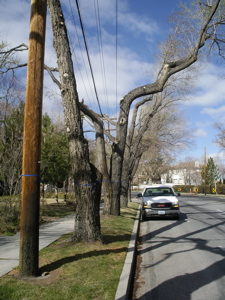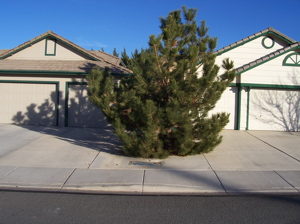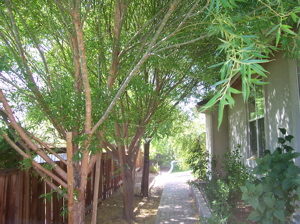
When selecting a tree for planting it is best to match the type of tree to the site. There are many environmental factors that should be considered. Be sure to look at the growth habits of a species when making tree selections. A large tree without a strong centered trunk would be a poor match for a narrow site bordered by sidewalk.
- Evaluate the site.
- Select a tree that will fit the site when it’s mature in 15-20 years. Consider tree height, width and root system requirements.
- Plan an irrigation system (preferably drip).
The most common mistake made in matching a tree to a site is underestimating the size the tree will be at maturity. Look for mature examples of the variety you are considering in other landscapes around the area to understand visually how the tree may or may not fit into the site you are considering.

Hardiness Zone
Make sure the selected tree can tolerate the minimum temperatures in our area.
Soils
Many urban planting sites have compacted soils and are lacking nutrients. Use a soil tiller and apply soil amendments to the site before planting.
Light
Different species of trees tolerate sunlight differently. White birch and most pine trees are shade intolerant, as they require full sun. Maples and Linden trees perform well in shade.
Pests
The best way to avoid pest problems is to avoid planting tree types that are known to be vulnerable to pests in your area. Species like Golden Raintree and Ginko are pest resistant while Elm is not.

Obstacles
Sidewalks, driveways, house foundations, overhead power lines and underground utilities are potential obstacles for tree root systems. Trees like Silver Maple have invasive root systems that can damage property if planted in the wrong place. Ash, Mulberry, and Elm are shallow rooting while Oak and Pear are not.
Using Trees to Heat & Cool
Trees reduce summer temperatures by as much as 20 degrees. Deciduous trees which lose their leaves in winter, are best to plant to the north. In summer, when days are warmer, the trees leaves will provide shade to the south and in winter, when days are cooler, the leaf-free tree will allow the sun to radiate to the south. Conifers, or evergreen trees, will create shade year-round.

Trees As Screens and Windbreaks
Trees are a good way to create a screen or windbreak. Low-branching conifers fit these jobs well. There are tall, narrow conifers available that can provide privacy and grow well in tight quarters. Trees can also be sited to block glare from oncoming traffic.
Beautifying the Landscape
Be sure to select a tree that meets the goals you have for your landscape. A fruit tree may be a desirable choice, or you may want to add bright fall colors to your yard. Flowering species can cause allergies but also attract birds.
Read more about Right Tree, Right Place at Arbor Day Foundation.
